Related Research Articles

HMS Royal Sovereign was a 100-gun first-rate ship of the line of the Royal Navy, which served as the flagship of Admiral Collingwood at the Battle of Trafalgar. She was the third of seven Royal Navy ships to bear the name. She was launched at Plymouth Dockyard on 11 September 1786, at a cost of £67,458, and was the only ship built to her design. Because of the high number of Northumbrians on board the crew were known as the Tars of the Tyne.

Admiral John Holloway was an officer of the Royal Navy who saw service during the American War of Independence, and the French Revolutionary and Napoleonic Wars, before serving as Governor of Newfoundland between 1807 and 1809.

Vice-Admiral Sir Henry Blackwood, 1st Baronet, whose memorial is in Killyleagh Parish Church, was an Irish officer of the British Royal Navy.
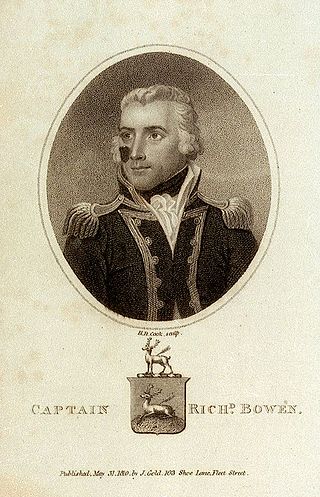
Richard Bowen was an officer of the Royal Navy who served during the American War of Independence and the French Revolutionary Wars. Bowen saw service with Horatio Nelson, and was killed fighting alongside him at the Battle of Santa Cruz de Tenerife.

Captain George Duff RN was a British naval officer during the American War of Independence, the French Revolutionary Wars and the Napoleonic Wars, who was killed by a cannonball at the Battle of Trafalgar.

The Battle of Cape Ortegal was the final action of the Trafalgar campaign, and was fought between a squadron of the Royal Navy and a remnant of the fleet that had been defeated earlier at the Battle of Trafalgar. It took place on 4 November 1805 off Cape Ortegal, in north-west Spain and saw Captain Sir Richard Strachan defeat and capture a French squadron under Rear-Admiral Pierre Dumanoir le Pelley. It is sometimes referred to as Strachan's Action.
James Alms was an officer of the Royal Navy who saw service during the War of the Austrian Succession, the Carnatic and Seven Years' War and the American War of Independence, rising to the rank of post-captain.

HMS Centaur was a 74-gun third rate of the Royal Navy, launched on 14 March 1797 at Woolwich. She served as Sir Samuel Hood's flagship in the Leeward Islands and the Channel. During her 22-year career Centaur saw action in the Mediterranean, the Channel, the West Indies, and the Baltic, fighting the French, the Dutch, the Danes, and the Russians. She was broken up in 1819.
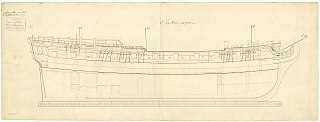
HMS Seahorse was a 24-gun sixth-rate frigate of the Royal Navy, launched in 1748. She is perhaps most famous as the ship on which a young Horatio Nelson served as a midshipman. She also participated in four battles off the coast of India between 1781 and 1783. The Royal Navy sold her in 1784 and she then became the mercantile Ravensworth. She made one voyage for the British East India Company (EIC) between 1786 and 1788. In 1789, she was sold to the French East India Company which had her refitted and renamed her Citoyen. In 1793 the French Navy purchased her and used her as a frigate. She was last listed in 1801.
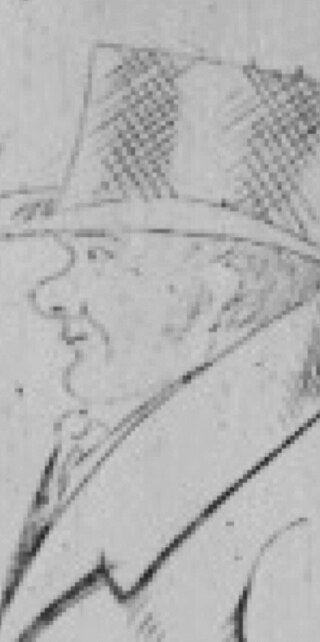
Rear-Admiral Samuel Sutton was an officer in the Royal Navy. He entered the service shortly after the start of the American War of Independence, and spent most of his early career serving with Captain and later Admiral Joshua Rowley. He saw action at several engagements with the French fleets in the West Indies, and ended the war as a lieutenant. Left without active employment by the following years of peace, Sutton briefly returned to service during the Spanish Armament in 1790, but the outbreak of the French Revolutionary Wars in 1793 brought him steady work. After serving in a number of ships and being present at Cornwallis's Retreat in 1795, Sutton received command of a sloop, and with it the opportunity to render a service to a member of the French aristocracy, and the future Charles X of France. Promoted for his good service, Sutton served as a flag captain to several admirals, including Horatio Nelson. He briefly commanded HMS Victory, before surrendering her to Thomas Hardy, who would go on to command Victory at Trafalgar, and be present at Nelson's death. Sutton instead took command of a frigate, and in 1804 was involved in a controversial action that saw the capture of three Spanish frigates and the destruction of a fourth. Made wealthy from the spoils, Sutton nevertheless remained in the navy, taking part in the chase of the French fleet to the West Indies in 1805. His health declined during this period, and he went ashore in October that year. He retired from active service, and served as a magistrate and local official for his community, being promoted to rear-admiral in 1821 and dying in 1832.

Admiral comte Pierre André de Suffren de Saint Tropez, bailli de Suffren, Château de Saint-Cannat) was a French Navy officer and admiral. Beginning his career during the War of the Austrian Succession, he fought in the Seven Years' War, where he was taken prisoner at the Battle of Lagos. Promoted to captain in 1772, he was one of the aids of Admiral d'Estaing during the Naval battles of the American Revolutionary War, notably taking part in the Siege of Savannah.

HMS Terpsichore was a 32-gun Amazon-class fifth-rate frigate of the Royal Navy. She was built during the last years of the American War of Independence, but did not see action until the French Revolutionary Wars. She served during the French Revolutionary and Napoleonic Wars, in a career that spanned forty-five years.
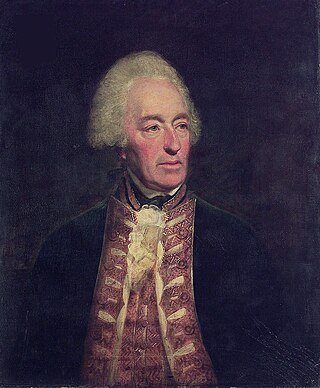
Robert Roddam was an officer of the Royal Navy who saw service during the War of the Austrian Succession, the Seven Years' War, and the American War of Independence. He survived to see the French Revolutionary and Napoleonic Wars, but was not actively employed during them.

Philemon Pownoll of Sharpham in the parish of Ashprington in Devon, England, was an officer of the Royal Navy who saw service during the War of the Austrian Succession, the Seven Years' War and the American War of Independence, rising to the rank of post-captain.

The action of 8 May 1744 was a minor naval engagement of the War of the Austrian Succession in which two French ships of the line, the 60-gun Content, and the 64-gun Mars, captured the British 70-gun HMS Northumberland after a desperate action lasting four hours. Northumberland's captain, Thomas Watson, and her second lieutenant were among those killed.
Admiral Matthew Barton was an officer of the Royal Navy. He rose to the rank of admiral during a long and distinguished career, in which he served in the War of Jenkins' Ear, the War of the Austrian Succession and the Seven Years' War. He fought at several major battles, and commanded a number of amphibious assaults off the French coast and in the West Indies. Though he lived until 1795 his health was broken after service in the tropics, and he never served at sea again after 1763.
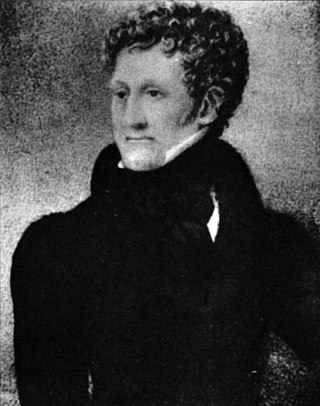
Rear-Admiral James Macnamara was an officer of the Royal Navy who served during the American War of Independence and the French Revolutionary and Napoleonic Wars.

The action of 22 May 1812 took place off Groix when a small French squadron comprising the French frigates Ariane and Andromaque, and the brig Mameluck returning from a commerce raiding campaign in the Atlantic, met the 74-gun HMS Northumberland while trying the slip to Lorient through the British blockade.
Vice-Admiral Sir Charles Hardy, also known as Sir Charles Hardy the Elder, was a Royal Navy officer of the eighteenth century. Hardy entered the Royal Navy in 1695, joining his cousin Captain Thomas Hardy's ship HMS Pendennis. Promoted to lieutenant in 1701, he served in several ships of the line before being promoted to commander in 1705. Hardy commanded sloops in the English Channel, Mediterranean and North Seas, before taking command of HMS Dunwich in 1709, in which he was promoted to post captain. Hardy subsequently served for a year at Jamaica before commanding two ships during the Great Northern War between 1718 and 1720. Having changed commands several times, in 1727 he fought at the thirteenth siege of Gibraltar in HMS Kent.

Rear-Admiral Sir Thomas Hardy was a Royal Navy officer of the late 17th and early 18th centuries. Having joined the navy sometime before 1688, Hardy's career was supported by Captain George Churchill, whom he served as first lieutenant during the Battle of Barfleur in 1692. Promoted to captain in 1693, Hardy served in the Channel Islands and off the coast of England until 1702 when he was given command of HMS Pembroke off the coast of Spain. He fought at the Battle of Cádiz, and subsequently discovered the location of the Franco-Spanish fleet through the intervention of his chaplain, which resulted in the Battle of Vigo Bay. Hardy was knighted for his services.
References
![]() This article incorporates text from a publication now in the public domain : Laughton, John Knox (1899). "Watson, Thomas (d.1744)". In Lee, Sidney (ed.). Dictionary of National Biography . Vol. 60. London: Smith, Elder & Co.
This article incorporates text from a publication now in the public domain : Laughton, John Knox (1899). "Watson, Thomas (d.1744)". In Lee, Sidney (ed.). Dictionary of National Biography . Vol. 60. London: Smith, Elder & Co.